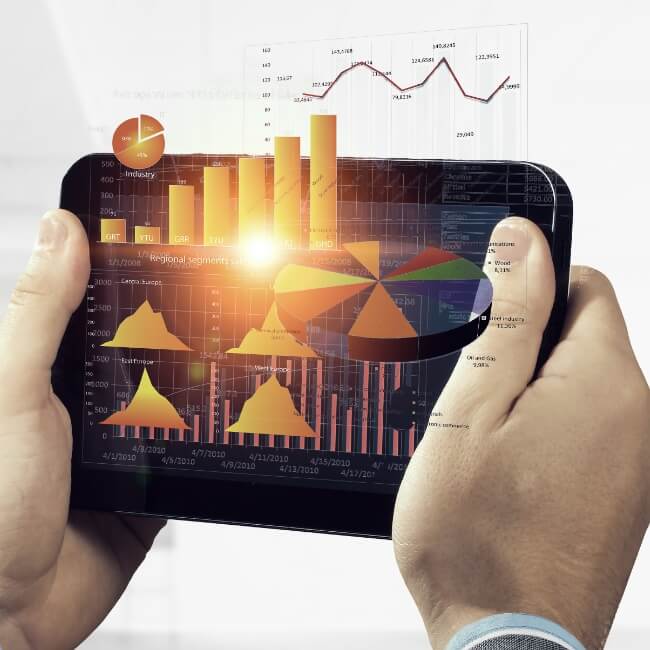Q: What will be the key strategies for the year 2025?
A:
- Maintain a high gross profit margin by focusing on products with complex manufacturing processes to reduce market competition.
- Focus on innovative products with high potential and alignment with global trends.
- Improve operational and production efficiency to reduce time and waste during the manufacturing process.
Q: How is the trend for Q1/2025?
A: Continued growth from 2024, with clear expansion in the automotive segment, which began generating revenue in Q3–Q4 of 2024, and additional new products expected to be introduced throughout 2025. The consumer goods segment will expand again through a broader variety of products under globally recognized brands. The medical segment will grow through new products that will enter mass production starting in Q1.
Q: What is the current capacity utilization of the company in terms of machinery and workforce? If we want to take on more work to expand the company, what needs to be done?
A: Currently, the company operates at around 60–70% capacity utilization, which is considered an optimal level, allowing room to accept new orders and opportunities. The remaining capacity can be used for R&D and improving production efficiency, while fixed costs remain manageable, maintaining competitiveness. The company also has a high level of cash reserves, and the factory infrastructure is ready to support expansion or increased production capacity. Production can be scaled up immediately by purchasing additional machines, which would take only 2–3 months. Meanwhile, the remaining capacity can still be used.
Q: Will the operational performance in 2025 be better than in 2024?
A: Operational performance is expected to grow significantly from Q1, both in terms of revenue and profit. The company targets 20% revenue growth.
Q: Looking at the mid-term business goals (3-5 years), what will POLY focus on? What changes can we expect compared to the present?
A: The company also aims to increase the proportion of revenue from non-automotive businesses to reduce the risk of overreliance on any single segment. Currently, the Medical and Consumer segments have already been added, and over the next 3–5 years, new product categories will continue to be introduced to support and sustain long-term growth.
Q: The gross profit margin (GPM) for medical products seems unusually high. Is this normal, or does this product category typically have a high GPM?
A: Medical products generally have high gross profit margins. For POLY, these products are innovative and complex to manufacture, with few competitors able to produce them. They require high investment and specialized expertise. Both machinery and tools are custom-designed for specific products to achieve maximum production efficiency. The production environment is mostly automated. As a result, products in this category have a high gross profit margin.
Q: Are our medical customers OEMs? Do we not have our own brand?
The company operates as an OEM, focusing on manufacturing by leveraging its facilities, machinery, and expertise in production and materials science, rather than building its own brand.
Q: Do you think medical products will replace electrical appliances?
A: The medical and electrical appliance product groups are clearly separate. In 2025, both are expected to grow alongside each other rather than one replacing the other.
Q: What is the planned CAPEX for 2025? How much in total?
A: For 2025, the company has planned CAPEX for factory expansion, including new machinery, testing equipment, and warehouse space to support increased orders and products in the energy and transmission line segment. The total budget is approximately 90 million THB.
Q: Which medical products will generate significant revenue for the company?
A: Medical products with high volume include blood transfusion tubing, needle locks, IV fluid connectors, and fertility enhancement devices, among others.
Q: Have we secured any Chinese automotive customers? Which car brands mainly contribute to revenue in this segment?
A: Currently, there are no automotive clients from China, as most Chinese vehicles are still being imported as complete units. However, local parts manufacturing is expected to increase in the future. If the pricing and gross margin align with the company’s policy, POLY will consider offering to produce these parts.
Q: Last year, the target was also 20% growth but was not achieved. How will you build investor confidence this year?
A: Although revenue growth did not meet the target, it still grew by 6%, defying a challenging environment and severe economic contraction. Additionally, net profit grew significantly—by 22%—exceeding targets, thanks to efficient production and management. In 2025, the economic environment is expected to recover, with signs of improvement already visible in Q4 of 2024. Therefore, the 20% growth target for 2025 is considered realistic.
Q: The company has a lot of cash on hand. Will there be any M&A deals?
A: The company continues to explore new business opportunities. If a new business aligns with its growth policy or supports expansion, it remains open to consideration.
Q: How much revenue is expected from the electrical insulator products?
A: The silicone electrical insulator market is still smaller than the porcelain market but is growing steadily. It is currently in the early stages and has begun to be used in some provinces. The initial revenue target for this segment is 20 million THB.
Q: How many competitors are there in the electrical insulator market?
A: There are still relatively few competitors, most of whom import from China. These products require international certification and rigorous engineering testing. The production process also integrates multiple disciplines such as electrical engineering, silicone materials, manufacturing techniques, and resistance testing, all of which require specialized experts and significant investment to meet quality standards.
Q: What is the company's revenue target for 2024, and what are the company's future goals?
A: The company aims to balance the revenue proportion across each business group to diversify risk and reduce reliance on any single business. The company will leverage its strength as a turn-key solution provider capable of entering all industries.
Q: What is the expected investment budget for 2024, and what will it be used for?
A: he investment budget for 2024 is approximately 80 million baht. Most of it will be allocated to tools and machinery. In the first quarter, there will be an investment in machinery for producing medical tools and equipment to meet increased customer orders. There are also plans to upgrade the production line to enhance efficiency and integrate automation and cobots to reduce reliance on manual labor in the future.
Q: What is the expected revenue growth for the entire year of 2024?
A: The company aims for at least a 10% revenue growth.
Q: How will the profitability for 2024 be?
A: The profitability for 2024 is expected to increase due to several factors. These include a reduction in raw material prices and lower energy costs resulting from decreased consumption due to the installation of solar panels, as well as lower electricity tariffs compared to the previous year. Additionally, financial costs are projected to remain low, and the benefits from the Board of Investment (BOI) tax incentives will further enhance profitability in 2024.
Q: How is the company setting its growth targets for this year, and what are the growth drivers?
A: The company aims for at least a 10% growth across all business segments. The focus will be on complex products that require advanced technology and precise machinery for production. This strategy targets markets with fewer competitors and higher gross margins.
Q: Why did our automotive sales increase QoQ? Was it due to new customers?
A: The increase is from an existing customer who started with us in 2023. They have relocated their production base, shutting down a factory in America and moving production to POLY. Most of the increased orders are for entirely new products.
Q: Will consumer product sales return to previous high levels, and is there potential for growth?
A: Postponed orders are still expanding to new markets in several countries. Currently, products have begun to be sold in Canada, Australia, New Zealand, and Japan. Additionally, consistent product development in collaboration with customers is ongoing, with plans to relaunch in the U.S. market by Q2 2025.
Q: Medical device sales QoQ appear stable. What is the outlook for next year?
A: The medical product group typically requires a lengthy validation process. Several products are still in this stage. By late Q4, production of surgical blood storage components will commence, and by 2025, all parts will be in production. This will serve as a key growth driver for the medical sector in 2025.
Q: What is the 2025 outlook and targets for the three business units (BUs)?
A: The global economy is expected to continue recovering gradually. Each BU has potential for steady growth: Automotive: Increasing orders from the U.S. with full production capacity beginning in 2025. Consumer Products: Relaunch opportunities and further market expansion into additional countries. Medical Devices: Continuous growth driven by new products and expanded markets for existing ones.
Q: Why is our GPM relatively high compared to peers in the industry?
A: The medical device segment inherently has a high gross profit margin due to the advanced technology involved in production, and this segment's revenue share is growing. Automotive revenue focuses on complex parts with less competition. Efficient management and automation systems also contribute to maintaining a higher margin.
Q: Does the company's business have seasonal fluctuations? If so, which quarter sees the highest to lowest impact?
A: The company’s sales or revenue do not exhibit significant seasonal variations. However, there may be minor impacts during long holiday periods, such as Songkran (Thai New Year) and the New Year holidays.
Q: Why is the company targeting 20% growth, despite revenues appearing flat or stagnant in 2024?
A: In 2024, most of the new orders are expected to materialize during Q3 and Q4, with gradual increases thereafter. Additionally, the automotive sector faced a significant contraction, which is why growth may not be evident compared to the previous year.
For 2025, automotive industry growth is projected to be substantial due to clients relocating production from the U.S., with full-scale production beginning in Q1 2025. These orders are expected to be sizable.
Moreover, the medical segment continues to show steady growth, driven by new products that will start sales in Q1 2025. These factors collectively support the company's ability to achieve 20% revenue growth.
Q: How much impact did the exchange rate fluctuations in Q3 have on the company?
A: The impact was minimal because most sales to customers, including international ones, are conducted in Thai Baht. While some imported raw materials are paid for in foreign currencies, the majority of raw materials are sourced domestically. Therefore, exchange rate fluctuations had limited effect on the company.
Q: Does the company record bonus expenses quarterly or only in Q4?
A: The company accrues bonus expenses monthly, based on the bonus payout rates from the previous year as a reference.
Q: How many more years will the BOI privileges that result in a 5% tax rate remain?
A: The company currently utilizes two BOI investment promotion certificates affecting corporate income tax:
- Medical tools and equipment: Benefits valid until 2025.
- Electrical appliances and automotive parts: Benefits valid until 2027.
For the certificate expiring in 2025, the company holds another BOI promotion certificate for medical tools and equipment with a 5-year validity, which has not yet been activated. Once the first certificate expires, the company can immediately utilize the benefits from the second certificate.
Q: How much can revenue in the automotive segment increase from the client relocating production from the USA?
A: Based on the customer's estimated orders, once all molds are completed, the revenue is expected to increase by approximately 50 million baht per quarter, equivalent to about 30% of the automotive segment's revenue.
Q: Please examples the product of each categories
A: Here are examples of products from each of Poly's main categories to clarify what the company manufactures and sells:
- Automotive Products: These include items like: Wire harness tubes, Car headlights and taillights, Vibration dampening rubber, Safety system components https://www.polynet.co.th/th/our-business/automotive
- Consumer Products: These include items like: Silicone packaging, Cleaning tools, Waterproof rubber seals in lighting equipment https://www.polynet.co.th/th/our-business/consumer-products
- Medical Devices and Equipment: These include items like: Blood transfusion equipment, Respiratory tubes, Fertility assistance devices https://www.polynet.co.th/th/our-business/medical-devices-and-equipment
For more visual examples and detailed descriptions of each product category, you can follow the links provided for further information.
Q: Is an NPM of 20% considered an overstatement of what the company can achieve?
A: Investors can be confident that the company follows accounting standards that are supported and certified by auditors. The financial figures showing an NPM of 20% are relatively high when compared to the industry average. This rate aligns with the company’s capabilities, supported by the following factors:
- The revenue proportion from the Medical product group, which has consistently grown. Medical products have a high gross margin because they require significant investment, utilize advanced technologies, and are complex. Additionally, strict regulatory standards must be met, resulting in fewer competitors and higher gross margins compared to other product groups.
- Efficient cost management:
- The efficient sourcing of raw materials and the company’s own compound factory help reduce raw material costs.
- Efficient production processes, including high-quality molds and continuous maintenance from the company’s in-house mold factory, as well as the use of automation systems that increase production while lowering costs.
- The use of renewable energy from solar power, reducing electricity costs by up to 25%.
- Low financial costs due to a relatively low level of debt.
- Tax benefits for medical instruments and equipment, electrical appliance parts, and automotive parts."
Q: Would the election of Donald Trump benefit or harm us?
A: Regarding Donald Trump's trade policies, the impact may lean more towards positive than negative, as his policies are more specific and focused on countries like China, Russia, and Mexico. Many products produced in these countries might need to be moved to other countries with less tension with the U.S. For Thailand, the outlook remains positive towards the U.S. similar to the previous administration. When Donald Trump started implementing trade policies from 2017 to 2021, Thailand was one of the key targets for relocating production from China. As a result, Thailand’s exports to the U.S. grew continuously.
Q: Will we benefit from the entry of Chinese automobiles?
A: There are still opportunities in this sector due to the conditions for promoting investment in Chinese automotive companies that establish companies and factories in Thailand. One of the requirements is that these Chinese companies must import and produce locally according to a specified ratio, which means a certain proportion of the parts must be produced domestically.
Q: Is there still a chance for the consumer goods client from America, who postponed their order, to return?
A: The project continues to involve product development in collaboration with the client on an ongoing basis. Additionally, marketing efforts have already expanded to other countries, and it is anticipated that marketing in the United States will resume in the second quarter of 2025."
Q: What is the outlook for penetrating the automotive market from China, and how is Polynet addressing this, or how significant are the opportunities?
A: The company remains open to all opportunities. Currently, Polynet has the capability to manufacture various components for Chinese automobiles, such as suspension system parts, safety system components, headlights, and taillights. The acceptance of orders is based on several factors, including pricing, profit margins, and long-term sustainability.
Q: What is the investment budget for 2024, and what will it be used for?
A: For 2024, the investment budget is approximately 70 million baht, primarily allocated for machinery upgrades and automation systems to enhance production efficiency and reduce reliance on labor. Additionally, the budget includes expanding the production capacity of medical tools and equipment production lines to accommodate increasing orders in the coming year.
Q: What will the profitability be like in the year 2024?
A: There are positive factors in many areas, including an economic recovery, a downward trend in energy and raw material costs, and low financial costs, which all contribute to higher profitability in 2024.
Q: The business goals in the medium term of 3-5 years, what areas will POLY focus on? What changes can be expected compared to the present?
A: The medium-term goal is to enhance production efficiency, collaborate with customers, and partner with both public and private entities to research and develop products that meet user needs at competitive prices. Additionally, the company will seek new business opportunities while ensuring the maximum benefit for shareholders.
Q: How is the declining trend in the Consumer business expected to perform throughout this year
A: Currently, customers have begun adjusting their marketing strategies by expanding sales to other countries to compensate for delayed orders due to the economic slowdown in the United States. Nevertheless, POLY continues to enjoy trust by receiving new product orders to partially replace the declining ones. Furthermore, consumer products in the Japanese market are still experiencing strong sales growth through promotional campaigns, ensuring continuous growth.
Q: What is the main strategies for the second half 2023?
A: Emphasizing product development to meet market demands and exploring new opportunities, such as collaborating on developing silicone-based products for Percutaneous Endoscopic Gastrostomy (PEG) with the Faculty of Medicine, Chulalongkorn University. Additionally, enhancing production efficiency, as mentioned earlier.
Q: Based on this year's performance, are the management confident that the company will be able to sustain growth next year amidst the current economic conditions?
A: The management closely monitors the economic situation and operational performance, considering uncertainties. Emphasis is placed on research and development, such as rubber formula enhancement, utilization of recyclable and eco-friendly materials. Production efficiency is improved through automation, mold development, and energy-saving initiatives. These measures ensure high-quality, competitive products.
Q: What is POLY's profitability outlook for 2023?
A: POLY aims for a preliminary profit margin of 25-30% from the revenues rebounding in Q3-Q4. Costs are decreasing, including sales and administrative expenses, targeted at 8-9% of revenue. Financial costs are low due to debt repayments and BOI tax benefits, boosting profitability compared to the first half of the year.
Q: What is the trend for the third quarter of 2023?
A: In the third quarter, several new products have started to mass production, restoring revenue lost from the consumer goods segment. Costs are decreasing with trends in raw material and energy price reductions as mentioned before.
Q: Is the operational performance expected to improve in the latter half of the year compared to the first half?
A: In the second half, several positive factors emerge, including decreasing raw material prices, reduced energy costs from successful installation and operation of solar cells, and ongoing risk mitigation plans. Automation improvements enhance production efficiency, while mold development increases production rates and reduces waste. External factors include rising consumer confidence and increasing purchasing trends, reflecting an optimistic economic outlook.
Q: What is the company's revenue target for the year 2023, and what are its future goals?
A: Currently, around 65% of the revenue comes from the automotive sector, approximately 18% from consumer goods, and about 17% from the medical equipment segment. POLY aims to balance revenue among these sectors, reducing reliance on any one area. We plan to accelerate growth in consumer goods and medical equipment through marketing initiatives and collaborations with institutions, ensuring products provide excellent customer experiences.
Q: Is there a plan for Joint Ventures (JV) and Mergers & Acquisitions (M&A) in 2023, and what is the value of these plans, and which business sectors are targeted?
A: Currently, the company does not have specific plans for JV and M&A activities. However, the company continues to explore growth opportunities that align with its policies and strategies, considering objectives that align with the company's vision, focusing on creating long-term value for shareholders.
Q: How is the additional investment planned for 2023 allocated, and what areas does it cover?
A: The investment plan for 2023 allocates an estimated budget of 300 million Baht. The major components of this plan include the installation of Solar cells, procurement of machinery to support production growth, and upgrading production lines for efficiency improvements.
Q: How much the company's total production capacity, and will there be an increase in production capacity in 2023 and how much for that?
A: The company's total production capacity is approximately 5,400 tons per year. The 2023 plan includes an increase of around 200 tons, mainly driven by the significant expansion of the production facilities in 2022 to accommodate the growing demands from various industries.
Q: How much can the installation of Solar cells in 2023 reduce electricity costs?
A: The Solar cell installation plan aims to produce a maximum electricity output of approximately 2.5 MW. Assuming an efficiency rate of 75% and 5 hours of electricity production per day, the installation can produce approximately 243,750 units of electricity per month. This electricity usage will directly offset the on-peak electricity cost, which is currently high due to the high ft rate.
Currently, POLY use electricity 900,000 units per month including on-peak and of-peak. We expects the electricity costs will reduce approximately 25%.
Q: How does the company plan to achieve a rapid growth rate, and from which industries will this growth come from?
A: The company has set a growth target of 15%, which will be achieved through growth in all industries, including potential business opportunities from new sectors that might arise in the future.
Q: In the year 2023, what concerns does the company have that might deviate from its set objectives?
A: Factors beyond the company's control, such as economic factors like economic downturns, inflation rates, are concerns. However, the company has planned and managed risks, developing strategies to handle potential future situations.
Q: The trend of raw material prices in the future and its potential impact on operations - what can be anticipated?
A: The trend in raw material prices is primarily based on oil prices due to the fact that many petrochemicals are derived from processes related to oil. In the year 2021, oil prices continued to rise steadily due to the ongoing conflict between Russia and Ukraine, which led to consecutive increases in oil prices. However, this situation has become more volatile. Oil prices started to decrease in the latter half of the year 2021. The trend in the year 2022 may need to be evaluated based on various factors such as economic conditions and the ongoing Russia-Ukraine conflict. Nevertheless, the company determines its selling prices based on costs. If there are changes in raw material prices in the future, selling prices will be adjusted accordingly.






